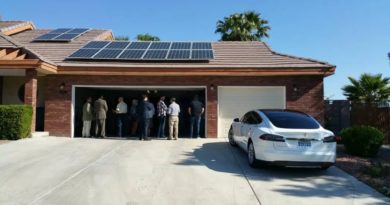Climate Resilience Starts at Home – Government Executive – GovExec.com
Energy Disrupter

When it comes to combating climate change, federal housing and community development programs should be strategically marshalled, due to their importance in helping to mitigate, respond to and recover from the effects of the crisis. While historically playing a supporting role, these programs should move to the climate resilience front lines, given the Biden administration’s executive orders on climate change and its recent funding requests to Congress.
The dwellings in which we live are significant contributors to climate change. Data from the U.S. Energy Information Administration shows that approximately 20% of U.S. carbon dioxide emissions result from residential energy use. As researchers at the University of Michigan reported last year, that level of emissions would be considered the world’s sixth largest green-house gas (GHG) emitter, similar in size to Brazil and larger than Germany. They also reported that while U.S. residential energy use has become more efficient in recent years, increases in population and the number of households will cause the sector to continue to be a major emitter of GHG in the decades ahead.
Programs to lower emissions from U.S. residential infrastructure will be critical to meeting the Administration’s climate change goals. Moreover, the effects of climate change have a disproportionate effect on people with low or moderate income. Affordable housing stock tends to be built in flood-zones and/or with substandard materials, leaving low-income renters at higher risk of being displaced due to natural disaster, and negatively impacting affordable housing stock where these dwellings are less likely to be rebuilt.
Programs administered by the Housing and Urban Development Department—vouchers used to subsidize rent and loans backed by the Federal Housing Administration—directly touch about 13 million U.S. households with many millions more impacted by the department’s policies. In addition, HUD plays a lead role in supporting community development efforts and helps cities and towns recover from natural disasters. HUD’s programs recognize that without adequate housing and sound community planning, individuals and families are vulnerable to life and safety risks, including threats from climate change.
As recent experience has shown, climate-change related costs are high and growing. Of the nearly $2 trillion in taxpayer costs for federal disaster relief over the past four decades, nearly half has been incurred during the past 10 years. As we face an increasing pace of extreme weather events, HUD must have tools to mitigate risk in advance and consider resilience as part of the response to disaster when it happens.
President Biden’s recent executive order on climate-related financial risk holds great promise for helping the government coordinate policies and budgetary resources to achieve the administration’s target of a net-zero emissions economy by 2050. Housing and community development policies will be a key factor in progress along these lines, so HUD must have a seat at the table, supported with the budgetary resources required to realize that goal. There’s significant work to be done.
Past executive branch reports to Congress on climate change include nary a mention of HUD, except occasionally in a supporting role. But recent proposals show that federal and Congressional leaders are taking a fresh look at efforts for climate change resilience and the role HUD can play. The administration’s National Climate Task Force, of which HUD is a member, has given HUD greater influence. The American Jobs Plan proposes $213 billion to produce, preserve, and retrofit more than two million affordable and sustainable homes. Programs and policies included in the president’s budget request to Congress for fiscal year 2022 expand on these steps.
The president’s budget proposes investing more than $36 billion to help combat climate change above and beyond American Jobs Plan investments. For HUD, the administration is requesting $800 million in new investments to advance climate change resilience and sets other policies that suggest a move toward incorporating housing and community development as a central component of climate change resilience. The budget also reflects proposals in the American Jobs Plan to promote climate resilience building activities, including $2.5 billion for a targeted Community Development Block Grant Fund for climate resilience.
Those proposed policies and new investments signal a real change and represent a down payment on what is needed to address climate change and increase resilience to the effects of climate change in our communities and homes. But there’s still a long way to go to realize the potential impact HUD can have. Congress should ensure HUD has sufficient funding and authority to perform in this critical role. And HUD should work across bureaucratic silos to bring the entire housing community on board with this new mission. But the initiatives proposed represent a good start at tackling climate change from where we live, and in doing so also make advances in equity and environmental justice that can result in economic growth more broadly.
Sarah Cunningham, a director at Summit Consulting, and Doug Criscitello, a managing director at Grant Thornton Public Sector, are former officials with the Housing and Urban Development Department.
Original Source: https://www.govexec.com/management/2021/07/climate-resilience-starts-home/182692/















